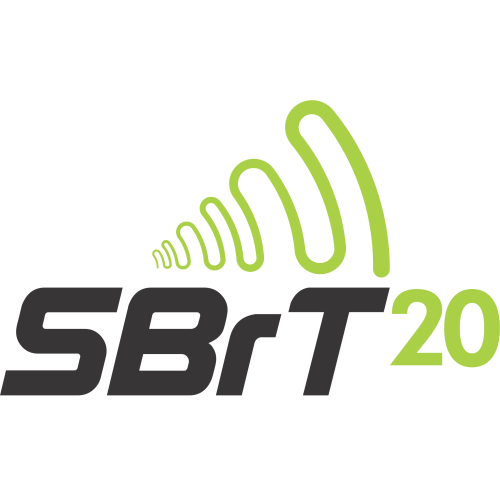
XXXVIII Simpósio Brasileiro de Telecomunicações e Processamento de Sinais
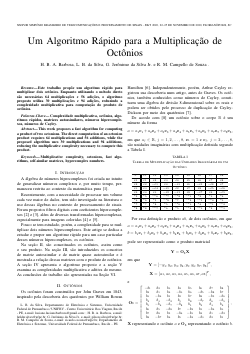
Um Algoritmo Rápido para a Multiplicação de Octônios
Luciano Barboza Silva, Hélder Barbosa, Gilson Jerônimo da Silva Jr., Ricardo M Campello de Souza
DOI: 10.14209/SBRT.2020.1570658261
Keywords: Octonions Fast algorithms Self-similar matrices Hypercomplex numbers
Abstract
This work proposes a fast algorithm for computing a product of two octonions. The direct computation of an octonion product requires 64 multiplications and 56 additions, while the proposed algorithm uses 30 multiplications and 94 additions, reducing the multiplicative complexity necessary to compute this product.Download

Modelo Complexo eta-mu Bivariável com Desbalanceamento de Clusters
Alessandro Paulo de Oliveira, Thiago Bairros, Rausley Adriano Amaral de Souza, Michel Daoud Yacoub
DOI: 10.14209/SBRT.2020.1570658277
Keywords: eta-mu distribution fading channels bivariate phase envelope joint distribution.
Abstract
In this paper, a fading model for the complex bivariate eta-mu channel, with an imbalance between the number of clusters of the in phase and quadrature components, is proposed. An exact closed-form expression for the joint probability density function including the two envelopes and their corresponding phases is obtained. It is assumed that the correlation occurs between the respective in phase components with each other and the respective in quadrature components with each other of the eta-mu signals. The proposed model generalizes two models already presented elsewhere in the literature.Download
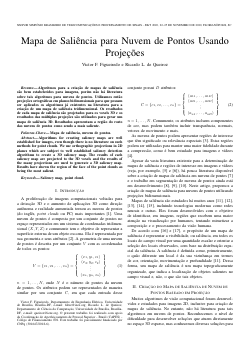
Mapa de Saliência para Nuvem de Pontos usando Projeções
Victor F Figueiredo, Ricardo de Queiroz
DOI: 10.14209/SBRT.2020.1570658395
Keywords: Mapa de saliência Nuvem de pontos
Abstract
Algorithms for creating saliency maps are well established for images, even though there is no literature on such methods for point clouds. We use orthographic projections in 2D planes which are subject to well established saliency detection algorithms to create a 3D saliency map. The results of each saliency map are projected to the 3D voxels and the results of the many projections are used to generate a 3D saliency map. As a future work it is proposed to use the saliency map to assist in the compression of point cloud.Download
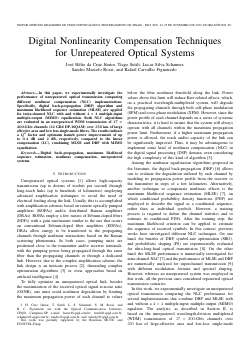
Digital Nonlinearity Compensation Techniques for Unrepeatered Optical Systems
José Hélio da Cruz Júnior, Tiago Sutili, Lucas Silva Schanner, Sandro M. Rossi, Rafael C. Figueiredo
DOI: 10.14209/SBRT.2020.1570658398
Keywords: Digital back-propagation Maximum likelihood sequence estimation Nonlinear compensation Unrepeatered systems
Abstract
In this paper, we experimentally investigate the performance of unrepeatered optical transmission comparing different nonlinear compensation (NLC) implementations. Specifically, digital back-propagation (DBP) algorithm and maximum likelihood sequence estimation (MLSE) are applied for intra-channel NLC with and without 4x4 multiple-input multiple-output (MIMO) equalization. Both NLC algorithms are evaluated in an unrepeatered WDM transmission of 17x200-Gb/s channels (32 GBd DP-16QAM) over 350 km of large effective area and low loss single-mode fibers. The results indicate a Q^2 factor and optimum launch power improvements of up to 0.4 dB and 2 dB, respectively, compared to the linear compensation (LC), combining MLSE and DBP with MIMO equalization.Download
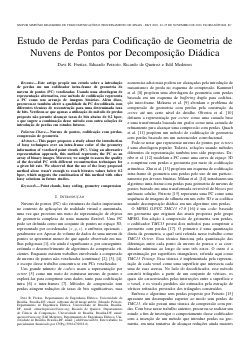
Estudo de Perdas para Codificação de Geometria de Nuvens de Pontos por Decomposição Diádica
Davi R. Freitas, Eduardo Peixoto, Ricardo L de Queiroz, Edil Medeiros
DOI: 10.14209/SBRT.2020.1570658416
Keywords: Nuvens de pontos Codificação com perdas Compressão de geometria
Abstract
This paper proposes a study about the introduction of lossy techniques over an intra-frame coder of the geometry information of voxelized point clouds (PC). Using an alternative representation approach, this method represents the PC as an array of binary images. Moreover, we sought to assess the quality of the decoded PC with different reconstruction techniques for a given bit rate. We observed that the use of the lossy proposed method alone wasn't enough to reach bitrates values below 0.2 bpov, which suggests the combination of this method with other lossy solutions in future studies.Download

Detecção de tráfego anômalo de rede utilizando clusterização em Big Data
Mateus Rocha, Daniel G Silva
DOI: 10.14209/SBRT.2020.1570658430
Keywords: Big Data clustering network intrusion detection
Abstract
Nowadays, the sheer amount of information sent through the Internet enables the adoption of Big Data and machine learning frameworks in order to detect network anomalies. However, there are two key challenges: the processing latency due to huge amounts of data and the reduced flexibility that supervised learning paradigm may cause. In this paper, we propose a Big Data framework that uses unsupervised learning for near real time intrusion detection, which is also capable of periodically retrain the generated models in order to track the network dynamics. The framework is succesfully tested with a well-known dataset and with real network traffic from a reverse proxy server.Download

Synthesis of sung Spanish vowels in lyrical singing by sopranos using the Fant source-filter theory and the Rosenberg glottal pulse model
Luis E Barrientos Sandoval, Edson Cataldo
DOI: 10.14209/SBRT.2020.1570658444
Keywords: Voice synthesis Singing voice Rosenberg model Glottal signal
Abstract
This paper aims to synthesize the sung Spanish vowels with covering considering the soprano vocal category of lyrical singers, including variation of sustained pitches with vibrato effect. The Fant source-filter theory is used to model the production of the sustained vowels. The source is based on the Rosenberg glottal pulse model and filter (the vocal tract) is composed by an all-pole filter model with formant frequencies and bandwidths from the vowels of Spanish language. All the sounds synthesized are available to be accessed and they were submitted to a group of listeners and they received a very good evaluation with respect to their intelligibility and naturalness.Download
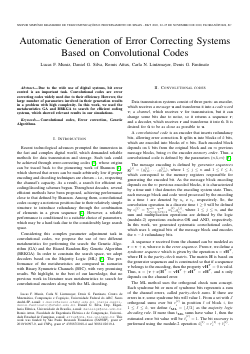
Automatic Generation of Error Correcting Systems Based on Convolutional Codes
Lucas Fernandes Muniz, Daniel G Silva, Romis Ribeiro Attux, Denis Fantinato, Carla Lintzmayer
DOI: 10.14209/SBRT.2020.1570658446
Keywords: Convolutional codes Error correction Genetic Algorithms
Abstract
Due to the wide use of digital systems, bit error control is an important task. Convolutional codes are error correcting codes widely used due to their efficiency. However, the large number of parameters involved in their generation results in a problem with high complexity. In this work, we used the metaheuristics GA and BRKGA to search for efficient coding systems, which showed relevant results in our simulations.Download
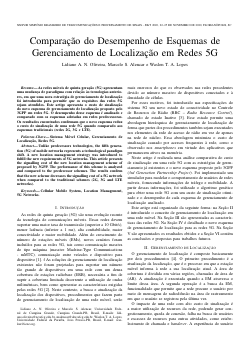
Comparação do Desempenho de Esquemas de Gerenciamento de Localização em Redes 5G
Lidiano Oliveira, Marcelo S. Alencar, Waslon Lopes
DOI: 10.14209/SBRT.2020.1570658447
Keywords: Cellular Mobile System Location Management 5G Networks
Abstract
Unlike predecessors technologies, the fifth generation (5G) of mobile networks represents a technological paradigm shift. A new location management strategy was introduced to fulfill the new requirements of 5G networks. This article presents the signalling cost of the new location management scheme of proposed by 3GPP. The performance of this scheme is analyzed and compared to the predecessor schemes. The results confirm that the new scheme decreases the signalling cost of a 5G network when compared to the traditional schemes (2G, 3G and LTE networks).Download

Caracterização de um Filtro Passa-Banda em banda X utilizando Ressoadores de Anel Dividido Retangulares para diferentes Condições de Contorno
Mateus F Belício, Fernanda Silva
DOI: 10.14209/SBRT.2020.1570658453
Keywords:
Abstract
This work presents the effects of different boundary conditions in bandpass filter implemented with a rectangular split ring resonator (SRR). A characterization is performed with three different boundary conditions. The basic characteristics of the bandpass filter are used for different boundary conditions. The filter was simulated to operate in the X. tThe filter were simulated in the CST Studio software.Download